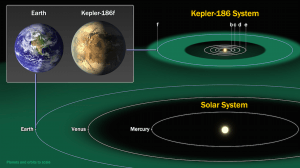
Image Courtesy of NASA Ames/SETI Institute/JPL-Caltech
Source: http://commons.wikimedia.org/wiki/File:Kepler186f-ComparisonGraphic-20140417.jpg
Researchers at the Keck Observatory and the Gemini Observatory have discovered a planet that could very much resemble our own. Every star has a zone on its orbit in which water may exist in liquid form. This is deemed the “habitable zone” because it is thought that life cannot thrive without liquid water. Stars with a lower mass have larger habitable zones. Specifically, M dwarfs, stars with 0.1 to 0.5 times the mass of our sun evolve very slowly, and thus their habitable zones stay constant for billions of years (1). Kepler-186 is an M-1 dwarf star that is 500 light years away, and it hosts five planets within its solar system. Four of these planets orbit Kepler-186 in short orbits and are too warm to be deemed habitable. However, one planet, Kepler-186f is roughly earth’s size and falls within the habitable zone. “What makes this finding particularly compelling is that this Earth-sized planet, one of five orbiting this star, which is cooler than the Sun, resides in a temperate region where water could exist in liquid form,” says Elisa Quintana of the SETI Institute. (2) Kepler-186 is a very dim star, being over half a million times fainter than the faintest stars we can see with the naked eye (2). Steve Howell, Kepler’s Project Scientist, reflected on our inability to accurately view Kepler-186f and its host star with today’s technology. “However, what we can do is eliminate essentially all other possibilities so that the validity of these planets is really the only viable option.” (2) The team did this by compiling extremely high spatial resolution observations from the Gemini North telescope in Mauna Kea that used a technique called speckle imaging and the Keck II telescope that used a technique called adaptive optics. This compilation of data allowed them to rule out possibilities that could confound the Kepler telescope’s observations (2). “The observations from Keck and Gemini, combined with other data and numerical calculations, allowed us to be 99.98% confident that Kepler-186f is real,” says Thomas Barclay, a Kepler scientist (2). According to Quintana, “These Earth-sized planets are extremely hard to detect and confirm, and now that we’ve found one, we want to search for more.” (2)
References:
- Elisa V Quintana. “An Earth- Sized Planet in the Habitable Zone of a Cool Star.” Science Magazine, http://www.sciencemag.org/content/344/6181/277.full(accessed April 25, 2014)
- Gemini Observatory. “First potentially habitable Earth-sized planet confirmed by Gemini and Keck observatories.” ScienceDaily. www.sciencedaily.com/releases/2014/04/140417141946.htm (accessed April 25, 2014).